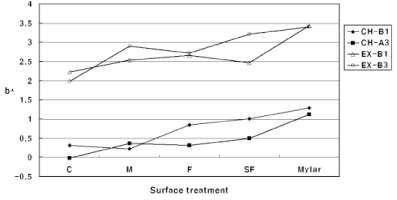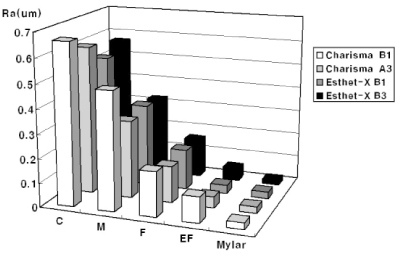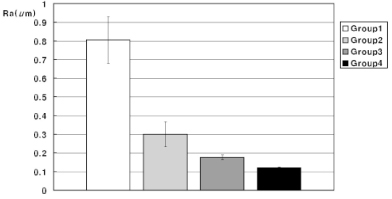Articles
- Page Path
- HOME > Restor Dent Endod > Volume 31(4); 2006 > Article
- Original Article Influence of the Surface roughness on translucency and surface color of the dental composite resins
- Kyu-Jeong Cho, Su-Jung Park, Hyun-Gu Cho, Dong-Jun Kim, Yun-Chan Hwang, Won-Mann Oh, In-Nam Hwang
-
2006;31(4):-322.
DOI: https://doi.org/10.5395/JKACD.2006.31.4.312
Published online: July 31, 2006
Department of Conservative Dentistry, School of Dentistry, DSRI, Chonnam National University, Korea.
- Corresponding Author: In-Nam Hwang. Department of Conservative Dentistry, School of Dentistry, Chonnam National University, 5 Hak-dong, Dong-gu, Gwangju, Korea, 501-757. Tel. 82-62-220-4443, Fax. 82-62-225-8387, hinso@jnu.ac.kr
Copyright © 2006 Korean Academy of Conservative Dentistry
- 1,164 Views
- 0 Download
- 3 Crossref
Abstract
-
The objectives of this study were to evaluate the effect of surface roughness on the surface color and translucency of the composite resins.Two composite resins (Esthet-X, Dentsply, Milford, USA and Charisma, Kulzer, Domagen, Germany) were used to investigate the surface color. Charisma was used to investigate the translucency. 40 disc samples (diameter: 8 mm, thickness: 5 mm) were made by each product to measure the surface color. Polymerized each sample's one side was treated by Sof-Lex finishing and polishing system (Group C, M, F, SF). 40 disc samples (diameter: 6 mm, thickness: 1 mm) were prepared to measure the opacity. 1 mm samples were ground one side with #600, #1000, #1500 and #2000 sandpapers. CIE L*a*b* values of each 5 mm thickness samples, and XYZ values of 1 mm thickness samples on the white and black background were measured with spectrophotometer (Spectrolino, GretagMacbeth, Regensdorf, Switzerland).Mean surface roughness (Ra) of all samples before and after surface treatment was measured using the Surface Roughness Tester SJ-301 (Mytutoyo, Tokyo, Japan).Regardless of type and shade of the composite resin, L* values measured in group C were higher than others (p < 0.05), and L* value decreased as the Ra value decreased except B3 shade of Esthet-X. But there were no significant difference in a* values among groups. In control group and SF, highest b* values were measured (p < 0.05), except B1 shade of Esthet-X.Contrast ratio decreased as the Ra value decreased (p < 0.05).With the above results, difference of surface roughness has influence on surface color and translucency of dental composite resins.
- 1. Lui JL, Low T. The surface finish of the new microfill restorative materials. J Oral Rehabil. 1982;9: 67-82.ArticlePubMed
- 2. van Noort R, Davis LG. The surface finish of composite resin restorative materials. Br Dent J. 1984;157: 360-364.ArticlePubMedPDF
- 3. Toledano M, De La Torre FJ, Osorio R. Evaluation of two polishing methods for resin composites. Am J Dent. 1994;7: 328-330.
- 4. Weitman RT, Eames WB. Plaque accumulation on composite surfaces after various finishing procedures. J Am Dent Assoc. 1975;91: 101-106.ArticlePubMed
- 5. Strassler HE. Polishing composite resins. J Esthet Dent. 1992;4: 177-179.PubMed
- 6. Bollen CM, Lambrechts P, Quirynen M. Comparison of surface roughness of oral hard materials to the threshold surface roughness for bacterial plaque retention; a review of the literature. Dent Mater. 1997;13: 258-269.PubMed
- 7. Chan KC, Fuller JL, Hormati AA. The ability of foods to stain two composite resins. J Prosthet Dent. 1980;43: 542-545.ArticlePubMed
- 8. Moon AJ, Kwon HC. A study on the surface roughness and reflectivity after polishing of the microfill, hybrid composite resins. J Korean Acad Conserv Dent. 1994;19: 513-533.
- 9. Lee JY, Shin DH. Surface roughness of universal composites after polishing procedures. J Korean Acad Conserv Dent. 2003;28: 369-377.Article
- 10. Park SH, Noh BD, Ahn HJ, Kim HK. Celluloid strip-finished versus polished composite surface: ifference in surface discoloration on microhybrid composite. J Oral Rehabil. 2004;31: 62-66.PubMed
- 11. Wilson F, Heath JR, Watts DC. Finishing composite restorative materials. J Oral Rehabil. 1990;17: 79-87.ArticlePubMed
- 12. Hondrum SO, Fernandez R Jr. Contouring, finishing, and polishing class 5 restorative materials. Oper Dent. 1997;22: 30-36.PubMed
- 13. Chung KH. Effects of finishing and polishing procedures on the surface texture of resin composites. Dent Mater. 1994;10: 325-330.ArticlePubMed
- 14. Ozgünaltay G, Yazici AR, Gorucu J. Effect of finishing and polishing procedures on the surface roughness of new tooth-coloured restoratives. J Oral Rehabil. 2003;30: 218-224.PubMed
- 15. Roeder LB, Tate WH, Powers JM. Effect of finishing and polishing procedures on the surface roughness of packable composites. Oper Dent. 2000;25: 534-543.PubMed
- 16. Yap AU, Lye KW, Sau CW. Surface characteristics of tooth-colored restoratives polished utilizing different polishing systems. Oper Dent. 1997;22: 260-265.PubMed
- 17. Setcos JC, Tarim B, Suzuki S. Surface finish produced on resin composites by new polishing systems. Quintessence Int. 1999;30: 169-173.PubMed
- 18. Bouvier D, Duprez JP, Lissac M. Comparative eveluation of polishing systems on the surface of three aesthetic materials. J Oral Rehabil. 1997;24: 888-894.PubMed
- 19. Yap AUJ, Sau CW, Lye KW. Effect of finishing/polishing time on the surface characteristics of tooth-coloured restoratives. J Oral Rehabil. 1998;25: 456-461.PubMed
- 20. Nagem Filho H, D'Azevedo MTFS, Nagem HD, Marsola FP. Surface roughness of composite resins after finishing and polishing. Braz Dent J. 2003;14: 37-41.ArticlePubMed
- 21. Reis AF, Giannini M, Lovadino JR, Ambrosano GM. Effect of various finishing systems on the surface roughness and staining susceptibility of packable resins. Dent Mater. 2003;19: 12-18.PubMed
- 22. Hachiya Y, Iwaku M, Hosoda H, Fusayama T. Relation of finish to discoloration of composite resins. J Prosthet Dent. 1984;52: 811-814.PubMed
- 23. Okazaki M, Douglas WH. Comparison of surface layer properties of composite resins by ESCA, SEM, and X-ray diffractometry. Biomaterials. 1984;5: 284-288.ArticlePubMed
- 24. Carlén A, Nikdel K, Wennerberg A, Holmberg K, Olsson J. Surface characteristics and in vitro biofilm formation on glass ionomer and composite resin. Biomaterials. 2001;22: 481-487.ArticlePubMed
- 25. Dodge WW, Dale RA, Cooley RL, Duke ES. Comparison of wet and dry finishing of resin composites with aluminum oxide discs. Dent Mater. 1991;7: 18-20.ArticlePubMed
- 26. Fruits TJ, Miranda FJ, Coury TL. Effect of equivalent abrasive grit sizes utilizing differing polishing motions on selected restorative materials. Quintessence Int. 1996;27: 279-285.PubMed
- 27. Tate WH, Powers JM. Surface roughness of composites and hybrid ionomers. Oper Dent. 1996;21: 53-58.PubMed
- 28. St Germain HA Jr, Meiers JC. Surface roughness of light-activated glass-ionomer cement restorative materials after finishing. Oper Dent. 1996;21: 103-109.PubMed
- 29. Pedrini D, Candido MSM, Rodrigues AL Jr. Analysis of surface roughness of glass-ionomer cements and compomer. J Oral Rehabil. 2003;30: 714-719.ArticlePubMedPDF
- 30. Wilder AD Jr, Swift EJ Jr, May KN Jr, Thompson JY, McDougal RA. Effect of finishing technique on the microleakage and surface texture of resin-modified glass ionomer restorative materials. J Dent. 2000;28: 367-373.PubMed
- 31. Yap AU, Wong ML, Lim ACY. The effect of polishing systems on microleakage of tooth-coloured restoratives. Part 2: composite and polyacid-modified composite resinscomposite and polyacid-modified composite resins. J Oral Rehabil. 2000;27: 205-210.PubMed
- 32. Bertrand MF, Leforestier E, Muller M, Pegurier LL, Bolla M. Effect of surface penetrating sealant on surface texture and microhardness of composite resins. J Biomed Mater Res. 2000;53: 658-663.ArticlePubMed
- 33. Ferracane JL, Condon JR, Nitchem JC. Evaluation of subsurface defects created during the finishing of composites. J Dent Res. 1992;71: 1628-1632.ArticlePubMedPDF
- 34. Cho LR, Yi YJ, Heo SJ. Effect of tooth brushing and thermal cycling on a surface change of ceromers finished with different methods. J Oral Rehabil. 2002;29: 816-822.PubMed
- 35. O'Brien WJ, Johnston WM, Fanian F, Lambert S. The surface roughness and gloss of composites. J Dent Res. 1984;63: 685-688.ArticlePubMedPDF
- 36. Campbell PM, Johnston WM, O'Brien WJ. Light scattering and gloss of an experimental quartz-filled composite. J Dent Res. 1986;65: 892-894.ArticlePubMedPDF
- 37. Albers HF. Tooth-colored restoratives. 1996;8th ed. Santa Rosa, CA: Alto books; 10. 1-10. 22.
- 38. Grajower R, Revah A, Sorin S. Reflectance spectra of natural and acrylic resin teeth. J Prosthet Dent. 1976;36: 570-579.ArticlePubMed
- 39. Seghi RR, Hewlett ER, Kim J. Visual and instrumental colorimetric assessments of small color differences on translucent dental porcelain. J Dent Res. 1989;68: 1760-1764.PubMed
- 40. Report of Councils and Bureaus. New American Dental Association Specification No. 27 for direct filling resins. J Am Dent Assoc. 1977;94: 1191-1194.PubMed
- 41. Hwang IN, Lee KW. Translucency of light cured composite resins depends on thickness & its influence on color of restorations. J Korean Acad Conserv Dent. 1999;24: 604-613.
REFERENCES

Values with same superscripts are not significantly different at p < 0.05 level among different surface treatment of same material.

Tables & Figures
REFERENCES
Citations

- Effects of Smokeless Tobacco on Color Stability and Surface Roughness of 3D-Printed, CAD/CAM-Milled, and Conventional Denture Base Materials: An In Vitro Study
Maryam H. Mugri, Saurabh Jain, Mohammed E. Sayed, Amjad Hussain Asiri Halawi, Safa Ahmed Ibrahim Hamzi, Raniya Abdulaziz Saad Aljohani, Zainab Mousa Ali Madkhali, Asaad Khalid, Hossam F. Jokhadar, Mai Almarzouki, Ghaida A. Alhumaidan, Ahid Amer Alshahrani
Biomedicines.2023; 11(2): 491. CrossRef - Optical characteristics of resin composite before and after polymerization
Ah-Hyang Eom, Duck-Su Kim, Soo-Hee Lee, Chang-Won Byun, Noh-Hoon Park, Kyoung-Kyu Choi
Journal of Korean Academy of Conservative Dentistry.2011; 36(3): 219. CrossRef - Surface roughness and color stability of various composite resins
Sung-Yi Lee, Hyeon-Cheol Kim, Bock Hur, Jeong-Kil Park
Journal of Korean Academy of Conservative Dentistry.2007; 32(6): 542. CrossRef










Figure 1
Figure 2
Figure 3
Figure 4
Figure 5
Figure 6
Figure 7
Figure 8
Figure 9
Figure 10
Composite resins used in this study
L*a*b* values of the tested materials Mean (S.D.), n = 10
Values with same superscripts are not significantly different at p < 0.05 level among different surface treatment of same material.
EColor difference (ΔE*) between control group and surface treated groups
Effect of surface treatment by Sof-lex disc on surface roughness (Ra, µm)
Values with same superscripts are not significantly different at p < 0.05 level among different surface treatment of same material.
Contrast ratio and mean surface roughness (Ra) resulting from various roughness of sandpaper
Values with same superscripts are not significantly different at p < 0.05 level.
Values with same superscripts are not significantly different at p < 0.05 level among different surface treatment of same material.
Values with same superscripts are not significantly different at p < 0.05 level among different surface treatment of same material.
Values with same superscripts are not significantly different at p < 0.05 level.

 KACD
KACD













 ePub Link
ePub Link Cite
Cite

